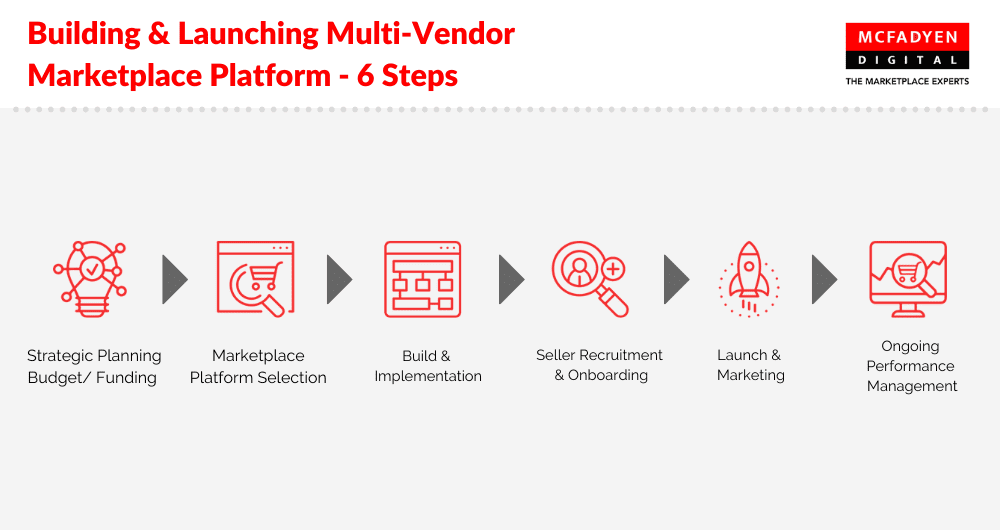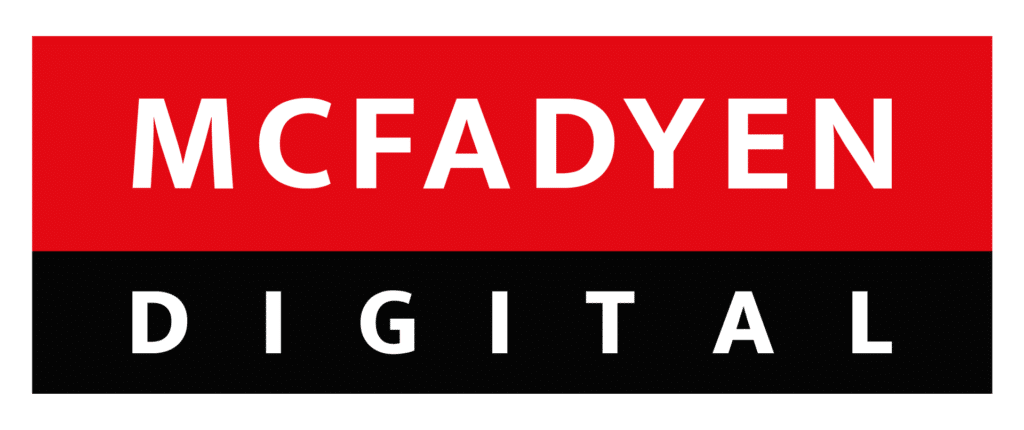
INTRODUCTION
Online Marketplaces continue to proliferate in the post-COVID world. The global market dynamics have also undergone many changes due to technological innovations, changing consumer habits, and regulations in a 24/7 connected world. A multi-vendor online marketplace is emerging as a massive platform to drive sales and grow revenue. The online marketplaces are seeing tremendous growth across sectors in B2B, and many manufacturers, distributors, wholesalers, and OEMs are now reaping the benefits of having their own online marketplace. As per Gartner analysts, close to 15% of medium and large online stores will have opened their own marketplaces by 2023. This will include goods and services of physical and digital products.

Let’s look at some exciting stats emphasizing an online marketplace’s size and growth potential.
So, what is a multi-vendor marketplace, and does it make sense to create one?
What is a multi-vendor marketplace?
A multi-vendor marketplace (ref to Fig 2) is an online platform that facilitates the sale of products and services from multiple vendors. Typically, the marketplace doesn’t manufacture products or own inventory. But there can be instances where the operator also has their own products like Amazon that retails their own branded products, 1st party products, and 3rd party products. The marketplace platform acts as a middle agent, connecting buyers with products or services from a seller network.

One of the key differences between traditional e-commerce platforms and the multi-vendor marketplace is the sheer scale. Multi-vendor marketplaces can have tens, hundreds, or even thousands of sellers from vast geographies, and their fintech and logistic requirements are complex in nature. While in an e-commerce store, it’s usually the e-commerce operator that does the function of sourcing products, setting pricing, fulfilling orders, etc. But in the multi-vendor marketplace, thousands of individual sellers do the sourcing and pricing while the marketplace entrepreneur looks at the building and balancing supply and demand.
From a technological standpoint, the multi-vendor marketplace platform requirements differ entirely from a traditional e-commerce site. This plays out in key functional areas like user profiles, reviews, online payment systems, admin panels, etc.
The multi-vendor marketplace business model is also slightly different, with the bulk of its revenue coming from third-party sales commissions. With no requirements to hold inventory, the marketplace has the potential to unlock the network effect and scale massive growth.
Now let us look at the advantages of Multi-vendor Marketplace.
Advantages of the Multi-vendor Marketplace
Let us start with the benefits a multi-vendor marketplace has for operators. The primary reason for a multi-vendor marketplace is to connect suppliers and buyers and act as a trusted platform to enable transactions. The marketplace monies off the commissions they charge off from each transaction. The whole business model of a marketplace makes it a win-win for all parties involved – the buyers, the sellers, and the marketplace operator.
Additional Revenue Source – When you add 3rd party when vendors to your marketplace, you are making commissions off each sale transaction that happens. Initially, this can cover some of the marketplace operational expenses before turning profits in the long run.
Wider Audience – When new sellers join the marketplace, they usually bring their own set of loyal customers along. This can be further amplified by choosing vendors that sell complimentary products. The broader audience base helps build the network effect.
Total Control – The marketplace business model and operating processes give complete control to the marketplace operator over what is displayed on the website. The marketplace platform provides all the tools the operator needs to maintain quality control and give the best user experience to the buyer. The operator can carefully curate the kind of vendors they want to have on their platform.
A multi-vendor marketplace platform works exceptionally for the sellers, too, as they don’t have to work from scratch on the digital infrastructure and get a ready audience for their products and services. Here are some of the benefits for sellers in the multi-vendor marketplace.
Inventory Management – The vendors/ sellers get full control to manage their inventory, ensuring availability is accurate and customers get the most updated information on the merchandise. This, in turn, drives more traction and traffic.
Tools for Promotion – Most modern marketplaces provide advanced tools to enable sellers to create targeted marketing campaigns that drive sales and traffic. These tools offer sellers even more power and control over how they run their operations in the marketplace.
Finally, the multi-vendor marketplace provides unmatched benefits to the buyer/ end consumer; let’s look at some key ones.
Broad Product Assortment – From a customer’s perspective, the marketplace always trumps regular e-commerce with the sheer number of available product choices. This creates stickiness for the website and helps generate the marketplace network effects.
Access to Global Market – With the multi-vendor marketplace, customers can access products from the global markets. A marketplace provides a truly borderless shopping experience to the buyer.
Trustworthy Shopping – With thousands of sellers in one place, customers feel safe and secure when transacting on a marketplace. An established marketplace provides an elevated level of trust between buyer and seller. Also, the access to verified reviews adds to the website’s credibility.
It is clear how a multi-vendor marketplace unlocks value and is profitable for all parties involved. Now let’s take a look at the steps to plan, build, and launch a profitable marketplace that can scale like a platform business.
Steps to Plan, Build, & Launch a Multi-vendor Marketplace
To teach you how to start a multi-vendor website and give you a holistic view, we have created a 6-step plan. This six-step plan (ref to Fig 3) has been derived from 15 years of building & implementing marketplaces, 20 years of personalizing customer journeys, and transforming omnichannel commerce, 250 Commerce clients from millions of SKUs to Billions of online sales as strategy, implementation, marketing & UX services. This guide should help you understand everything involved in building and launching a multi-vendor marketplace website.

STEP 1 – Strategic Planning & Budgeting/Funding
For large enterprises or even SMBs and startups, a business case is required to request internal funding for your company’s Marketplace initiative or raise capital from outside investors. Some strategic questions need answering at this stage. Is there strategic value to the company with this initiative? On a relative basis, where does this initiative rank in terms of value to the company vis-à-vis other investment alternatives? Does the business case justify the investment and meet our hurdle rates?
The business case is the financial representation of the proposed business initiative, including an overview of the opportunity, pro forma financials including revenue and expense projections, break-even analysis, assumptions and risk, and preferably a high-level execution plan and timeline. The business case must consider all the critical elements needed to build a successful business. At its highest level, the business case should be developed through the lenses of three key dimensions: the Business, the People, and the Technology. Each of these three lenses has critical elements within them that will be required to assess, develop, and fully understand the financial opportunity and impact on the company for the proposed Marketplace initiative. Once all these critical elements are evaluated and approved, the budget allocation needs to happen. Based on this, a Marketplace financial model is built.
Step 2 – Marketplace Platform Selection
Selecting the marketplace technology platform is one of the most critical steps in building a multi-vendor marketplace. The core capabilities of these multi-vendor enabling solutions include the ability to manage a multi-seller catalog, sellers, commissions, payment and tax, and order management. These are the foundational functions that transform a traditional (first-party) e-commerce site into a multi-vendor marketplace. From that central set of features, these marketplace-enabling options vary significantly in the types of features offered and the sophistication of those features. While there is a lot of industry research available to assess the competence of each marketplace software, one can refer to something like McFadyen Suite Spot Report to get a lowdown on the best marketplace platforms out there.
The Marketplace Suite Spot Report evaluates the top technologies businesses can use to create, launch, and grow a multi-vendor e-commerce ecosystem in the form of a marketplace, drop-ship, or hybrid model. Some solutions require a stand-alone e-commerce platform to handle the shopping and transacting functions, while some offer this functionality as part of an integrated full-stack suite.
Step 3- Build & Implementation
Having chosen a best-of-the-breed marketplace software that best fits the business’s unique requirements, the next step for the marketplace operator is to consider the build and implementation stage. The build stage presents three options: build, buy, and rent.
Building a marketplace eCommerce platform from scratch has its appeal. Every aspect is customized, from the coding language to the programming framework, the hosting/cloud environment to the front-end design, and everything in between. However, this also means the development team is responsible for making, executing, and taking credit or blaming those decisions.
Buying an eCommerce or marketplace platform offers much of the control of building a custom platform with the advantage of gaining the support of the platform provider, a regular feature release schedule, far less coding, and even optional interface themes for many modern platforms. It is essential to distinguish the heavy monolithic legacy platforms (ATG, Hybris, WebSphere Commerce) of the past from the next-generation platforms based around APIs with rich user interfaces, management tools, and very extensible architectures.
Renting a platform refers to a SaaS or PaaS platform subscription where the solution is hosted in the cloud and managed by the software vendor. The software is licensed for a fixed number of years (with options to extend) with a predictable cost. Subscribing to a SaaS platform will typically have less risk than a custom build. However, it provides less opportunity to differentiate from competitors. For example, about a million merchants are using Shopify, and most B2C sites offer a similar customer user experience.
The build and implementation is an important stage where critical pieces come together. Depending on the project’s complexity, it can take anywhere between twelve and twenty weeks. As a product development methodology, MVP focuses on building a workable product with minimum features for the early users, who then provide feedback for future product development. To test the production environment (where customers will shop), an identical testing environment is set up to uncover any environment or configuration-related issues. A complete testing environment includes hardware configuration, operating system settings, software configuration, test terminals, and other support to perform the test. Careful setup of the identical testing environment is critical to ensure reliable test results. The implementation plan, a subset of the overall project plan, moves the project plan into action. It identifies goals and objectives and describes project tasks, roles, and responsibilities. The critical components of an implementation plan are goals and objectives, scheduled milestones, resource allocation, and the definition of success metrics.
Step 4 – Seller Recruiting & Onboarding
A large supply of high-quality sellers is at the heart of any successful online marketplace. Building a two-sided marketplace should always begin with the supply side for two primary reasons. 1) Sellers are incentivized to find new revenue sources, while customers are not motivated to visit a marketplace with few or low-quality sellers. 2) Sellers can bring their existing customer base to the marketplace. But beyond simply bringing in any sellers, consideration should also be given to finding suitable sellers. Poor customer experience can cause significant damage to the marketplace’s reputation, so sellers should be vetted carefully. Fig 4 below refers to the steps involved in Seller Recruiting and onboarding.

Like a marketing and sales funnel, a seller acquisition consists of acquiring, onboarding, and retaining your marketplace’s best sellers. Moving potential sellers through the funnel identifies the sellers who best fit the marketplace. For example, just 5% of the sellers on Amazon account for over 40% of the revenue. Establishing an effective seller success funnel requires thoughtful and methodical time and effort but will save time and money in the long run. A structured and refined funnel can easily and rapidly attract high-quality sellers. There are five steps to the seller acquisition process.
Step 5 – Launch & Marketing
Launching and promoting an online marketplace involves many of the same considerations as a traditional eCommerce property with an additional audience to consider—the sellers. As with any successful marketing effort, it comes down to the target audiences requiring engagement. With traditional eCommerce, the primary audience is the end customer making the purchase. Marketplaces must also speak to third-party sellers to keep them informed, inspired, and engaged.
The heart of effective marketing is clear and timely communication. Getting the right message to the right person at the right time is a highly effective way to influence behavior and keep people interested positively. This applies to consumers as much as it does to sellers. Creating a comprehensive communications plan that includes audience identification, some level of persona development, and key journey mapping helps to deliver a consistent message across all major audiences. These steps are all too often skipped in the name of expediency, even though they provide a mechanism to ensure that the message being conveyed is the message the audience needs to hear.
Key things to consider when creating a marketplace marketing plan are;
Knowing the target audiences for consumers and sellers, including building out personas and journeys, is vital to effective marketing and communication.
Creating meaningful content and messaging for each audience keeps people engaged.
Deliver content and messaging on multiple relevant channels
Create and manage an integrated marketing communication stack consisting of a CRM platform and digital engagement platforms to provide a 360-degree view of audience engagement.
Step 6 – Ongoing Performance Management
Once the marketplace website is launched, two important things must be taken care of. First is the post-launch support and the most critical aspect of marketplace success – performance management. The post-launch support stage is when the marketplace is launched and is often referred to as hypercare. It’s a time immediately following a system Go Live where an elevated level of support is available to ensure the seamless adoption of a new platform. Hypercare support is a critical phase for the smooth rollout and handover of the new digital commerce portal after it goes live. When done well, Hypercare saves a lot of time and rollback of the applications. Hypercare in marketplace platform support is considered the phase after the application goes live in production. The main aim of the hypercare support service is to ensure that when hypercare support ends, the system should be stable and can be released to more end users.
At this stage, the focus is on customer support, platform stability, and data integrity. It requires collaboration between functional, technical, and security experts. Marketplace platforms are complex beasts, and unexpected issues need immediate resolutions to be contained to avoid any major roadblock to a successful implementation rollout. The best practice is to have dedicated support that understands where to channel their escalations to receive immediate resolutions. The team for this phase should have trained experts on the new platform and technical processes; each should be able to quickly identify the issue and resolve the problem in the system. Some of the key services that come under the purview of hypercare are:
Technical support services
On-site training services
Handling issues and queries
Escalation plan designing
The reasons why marketplaces fail vary, but one common thread is the lack of an articulated performance management strategy. Marketplace performance management consists of people, processes, tools, and a governance mechanism that ensures the marketplace is constantly tuned, tweaked, and operated based on critical performance data. Creating such a plan involves carefully considering which metrics are vital to the marketplace’s health across several critical areas related to products, buyers, and sellers. Once those metrics are identified, underlying data sources need to be defined, and individuals need to be responsible and accountable for the metrics’ accuracy and the consistent review and interpretation of the metrics with the goal of creating specific actions.
The quantitative output of a marketplace performance management strategy should ideally be a series of dashboards fed by any available meaningful source that can be quantified into the pre-defined key metrics. The marketplace operations team can then use these business intelligence (BI) dashboards and, by extension, the marketplace sellers to create actionable insights to ensure the right products are being offered to the right buyers by the right sellers at the right time.
McFadyen Digital’s Marketplace Performance Management Dashboard is an industry first best-practices-packed intelligence tool created for marketplace operators by marketplace experts. This system of powerful dashboards and reports helps ensure your marketplace operations team is measuring the right metrics to drive actionable intelligence that reliably translates into profit and scale.
Final Thoughts
Multi-vendor marketplaces are a complex beast to build, launch and operate. It needs orchestration between various disciplines like commerce, fintech, and logistics. Your multi-vendor marketplace journey begins with getting clarity on the marketplace model, developing your vision, and choosing the right platform for the job. Talk to the marketplace experts at McFadyen Digital to start your marketplace journey. We’ll examine your current online shopping strategy and technology, creating actionable steps to take things to the next level. No risk. No commitment. Just answers.
Related Articles
Turn Insight Into Impact.
Start Today.




